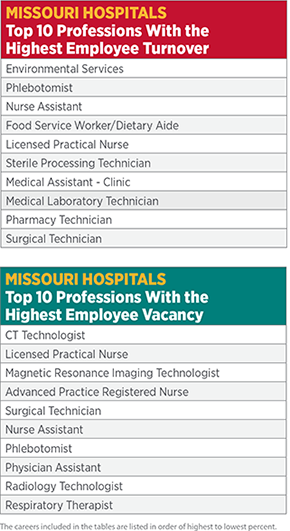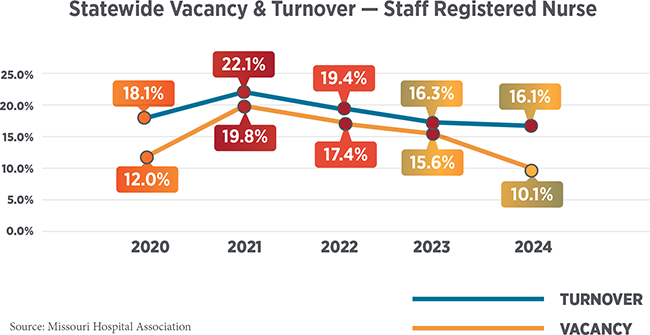MHA’s 2025 Workforce Report Also Finds Long-term Challenges Remain
JEFFERSON CITY, Mo. — Vacancy and turnover rates among registered nurses, and within the hospital workforce broadly, eased slightly in 2024, according to the Missouri Hospital Association’s 2025 Workforce Report. Overall, this is a positive sign for the hospital workforce, according to Jon D. Doolittle, MHA president and CEO.
“For hospital leaders and partners in workforce development, the report provides a signal for emerging issues and trends in the workforce,” said Doolittle. “The data help hospitals understand the local, regional and statewide talent environment, evaluate how to invest in workforce development individually and broadly, and shape their organization’s benefits and environment to remain employers of choice in highly competitive fields.”
Statewide Vacancy and Turnover

MHA’s workforce data collection focuses primarily on the influence of two components — vacancy (unfilled positions) and turnover (workers who leave the organization). Doolittle said both challenges can influence hospital operations and organizational morale. Doolittle said that’s why Missouri’s hospitals and their partners continually recruit, train and retain workers. They also innovate within their organizations to ensure hospital careers remain a great choice for entering and incumbent team members.
“A strong hospital workforce is essential to Missourians’ health,” Doolittle said. “The data indicate hospitals continue to make progress toward long-term sustainability from the record-high levels of workforce disruption during the pandemic. Most importantly, it indicates that opportunities exist in health care for careers that provide personal and professional growth for individuals who want to be part of building healthier and stronger communities.”
Staff Registered Nurses (R.N.s) are the largest single category of hospital employees, with a total worker pool of more than 37,000 individuals. Throughout the state, nearly 4,200 R.N. positions, or 10.1%, were vacant for lack of qualified applicants. However, between 2023 and 2024, R.N. vacancies declined by 5.5% — a significant year-to-year decline. Nurse turnover remains high, with more than 5,900 nurses, or 16.1%, leaving their hospital in 2024. This was a slight decrease from 16.3% in 2023.

Several other surveyed position categories support R.N.s in providing care. MHA surveys hospitals for vacancy and turnover of Licensed Practical Nurses and Nurse Assistants — the latter of which includes Patient Care Technicians, Certified Nurse Assistants and unlicensed assistive personnel. The vacancy rates for these workers are similar or slightly higher than R.N.s, but the turnover rate is significantly higher — nearly 41% for Nurse Assistants. Vacancy and turnover rates in these positions increase the pressure on the R.N. workforce.
“Despite the generally improved results in this year’s data, turnover rates in some positions remain uncomfortably high,” Doolittle said. “To serve patients and provide high-quality care, hospitals require a team acting in concert. Turnover and vacancies in assistive positions, imaging, lab services or pharmacy, for example, influence a hospital’s ability to provide care.”
Geography can influence the pool of available workers of all kinds. For example, in 2024, regional variation was evident in Staff R.N. data. While Missouri’s South-Central region has the lowest vacancy rate in the state at 3.5% — approximately one-third the statewide average — it has the highest turnover at 25%.
In the St. Louis region, hospitals experienced a turnover rate of nearly 77% in environmental services. Conversely, the vacancy rate is 5.6%. This disparity suggests little difficulty in filling these positions after separations. However, efforts to train and onboard these workers are time-consuming and costly.
“The hospital workforce is a top priority for hospital leaders,” Doolittle said. “MHA’s annual workforce report helps hospitals understand the workforce environment and build systems that help them deliver quality care.”
The report includes statewide and regional data from 127 hospitals and vacancy and turnover rates for 34 hospital- and clinic-based positions. A comprehensive collection of workforce data, trends and color-coded vacancy and turnover maps are available at MoHospitals.org.
The Missouri Hospital Association is a nonprofit association in Jefferson City that represents 137 Missouri hospitals. In addition to representation and advocacy on behalf of its membership, the association offers continuing education programs on current health care topics and seeks to educate the public about health care issues.
